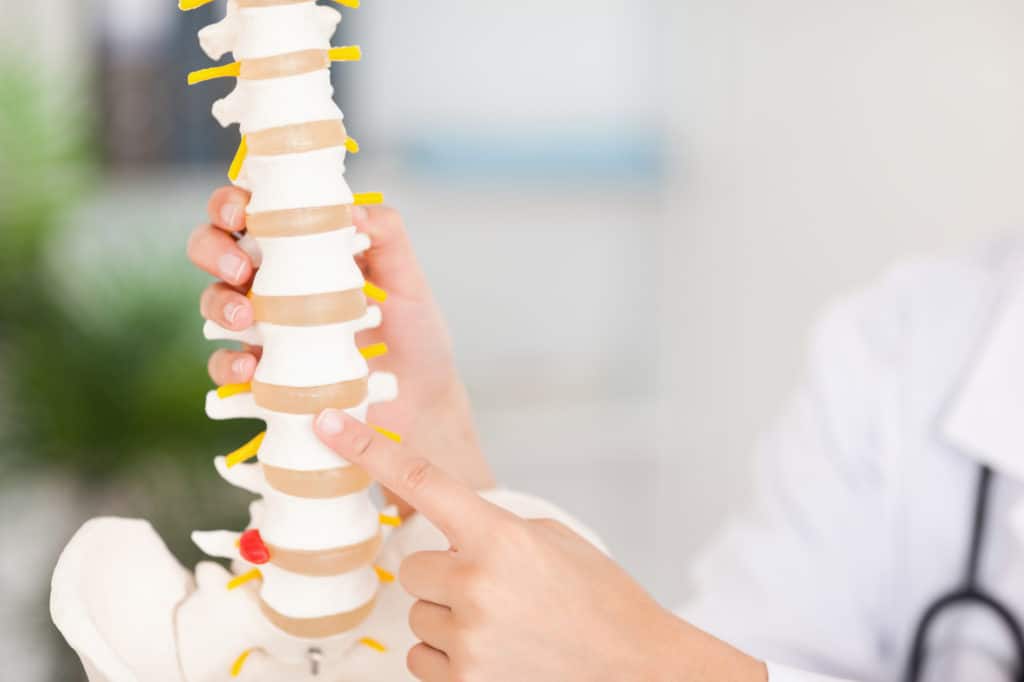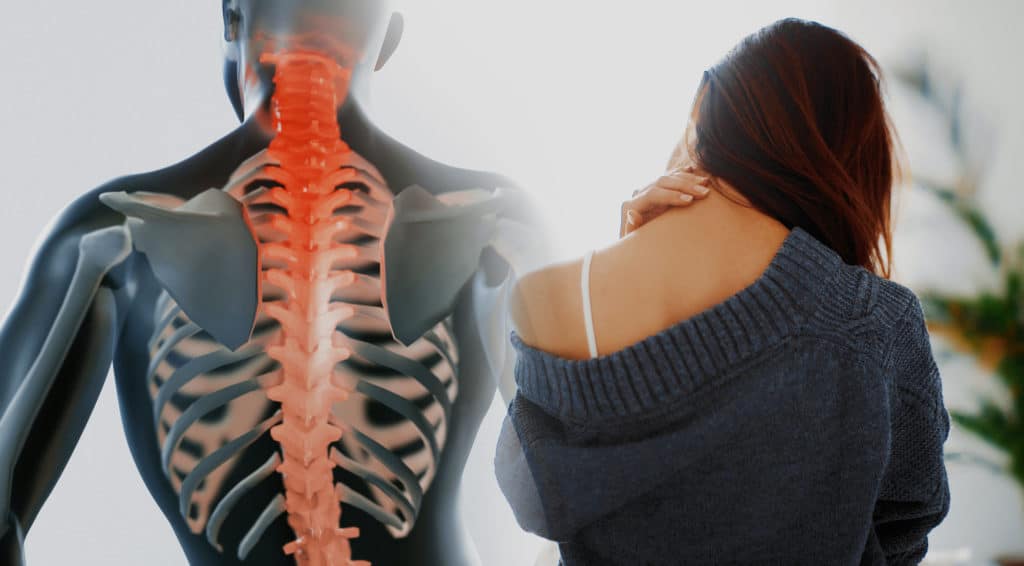
Have you got pain in your upper back that just won’t let up?
Upper back pain varies in intensity from mild, where you feel a twinge of pain. Moderate, which you’re more likely to feel with a sudden movement, sneezing, or deep breathing.
To the intense pain that stops you in your tracks and prevents you from doing anything. The bottom line is that “upper back pain” isn’t just one thing – it’s different from person to person.
Plus, there are many reasons you might have upper back discomfort or aches, which is different for everyone.
But the main thing to remember is you don’t have to endure it and stay miserable. We can fix it and help you get your life back. We tell you exactly what to do to stop your pain once and for all.
Understanding The Anatomy Of Upper Back Pain

In our experience (and from studying medical literature), upper back pain is far less common than neck or lower back pain. In fact, multiple medical studies suggest that most people report lower back and neck pain compared to upper back pain.
But where exactly is the “upper back”?
To clarify, when we talk about the upper back, we’re referring to the area between the low back (lumbar spine) and below the neck. In physical therapy, we call this area of the back the “thoracic spine.”
So why do fewer people complain of pain in this area of the back compared to the lower back or neck?
Well, that is most likely because the upper back/thoracic spine is the most stable part of the back. Why?
Because its range of motion is restricted due to the spine attaching to the rib cage in this area.
What Causes Pain In The Upper Back?

The spine is made up of vertebrae kept separate by disks. These disks are like shock absorbers with a soft gel core and exterior composed of cartilage, making them firm.
The spinal cord is encased within the spinal column with nerves connected to the brain and other body parts.
We don’t look at the spine as a single structure. Instead, we divide it into three; the Cervical spine (neck), thoracic spine (upper and mid back), and lumbar spine (lower back).
The thoracic spine’s movements differ from the other two because it is stable and connected to the sternum and ribs. While it is less liable to injury, most injuries that do occur are typically muscle related.
We like to compare the spinal cord to the trunk of a tree that bears the weight of the upper body (the leaves and branches). Working with specific muscles that link different sections of the skeleton together.
The muscles in the upper back that assist the spine in bearing the weight of the upper body include:
- Trapezius: Located near the shoulder blades. These muscles help you stand upright and erect, move your head, neck, shoulders, and upper body and assist you when you throw things – like a football or a tennis ball.
- Rhomboids: These muscles adjoin the trapezius on either side of the body. They offer support to the shoulders and help you to pull things.
- Latissimus dorsi: Although not limited to the upper back, they stretch to the middle and lower back. The large latissimus dorsi muscles help you extend the arms and move the shoulder blades. They’re also involved in breathing. You might have heard people call these muscles “your lats” in the gym.
One of these muscles is likely injured when you injure your mid to upper back when playing a sport, at the gym, or at work.
Generally, most upper back injuries and the cause of pain in the thoracic spine relate to a musculoskeletal issue – your bones, cartilage, ligaments, tendons, or connective tissue (fascia).
Damage to the spinal cord in the upper back is quite rare unless you’ve had an accident, suffered severe trauma to the thoracic spine, or have the bone-weakening disease osteoporosis.
What Are The Symptoms Of Upper Back Pain?

The specific symptoms you have directly relate to the root cause of your upper back pain. If you injure the upper back, some of the symptoms may include:
- Rigidity/Tautness
- Pain
- Tender to touch
- A headache
These symptoms are indicative of a muscle, tendon, or ligament strain.
When the pain in your upper back relates to the disks, nerves, or bones, the symptoms are more likely to be:
- Weakness/numbness in the legs
- Pain radiating downwards towards the legs
- Lower back pain
- Bowel/ urinary incontinence
If you have mild soreness in the upper back that seems to get worse with activity, it’ll probably get better on its own in a couple of days if you rest.
But if you have severe pain in the upper back with any of the following additional symptoms, you should seek urgent medical attention:
- You’re unintentionally losing weight
- You can’t control your bowels or bladder
- The pain stops you from sleeping or wakes you up in the middle of the night
- You have numbness or weakness in your legs
What Causes Upper Back Pain?

Upper back pain is primarily due to injuries like strains or sprains that are soft tissue related or chronic stress and muscle tension in the neck and shoulders.
But in our experience, some activities and behaviors are more likely to result in upper back pain. They include:
- Lifting heavy weights with poor posture
- Maintaining an incorrect posture while sitting, standing, or walking
- Sudden twisting movement of the upper torso
- “Text neck” caused by excessive smartphone use
- Any contact sport activity
- Suffering from a neck injury or whiplash
- Lifting hefty weights at the gym
- Carrying weighty backpacks
- Doing repetitive movements that involve the upper back
Treating Upper Back Pain

There are various treatments to treat pain in the upper back. If your pain is more like a mild discomfort or muscle tension, it may not require treatment – other than rest, hydration, and gentle movement.
A range of DIY remedies can also help with mild upper back pain. They include:
- Using heat therapy for swelling, pain reduction, and increased mobility
- Gentle stretching movements or exercises
- Taking over-the-counter pain medication for a very limited duration*
*We don’t tend to recommend medication. We would much rather identify and correct the underlying issue with physical therapy and help you avoid the negative health consequences of pain medication.
So rather than pop pills and try and fix your problems at home. If your pain is moderate to severe and warrants painkillers or you’re considering surgery, you should seek expert treatment from a physical therapy clinic, like RPM Physical Therapy, to find and treat the root cause first.
Back surgery should be the last and final option in all cases and only for chronic and severe cases that do not respond to physical therapy.
Another helpful way to treat and prevent upper back pain is maintaining the proper posture when going about your daily life. Good posture is critical to reducing strain on the spinal cord and the upper back.
A few ways to achieve this and stretch the upper back muscles are:
- First, lift the chest and ribcage slightly while standing, sitting, or walking.
- Tuck the chin in a while, sitting upright on a chair with feet on the floor and the shoulders relaxed and laid back. Gently lower the chin inwards towards the neck and hold for 5 seconds. Repeat a few times.
- Place your hands on the thighs, relax the shoulders and gently squeeze the shoulder blades inwards until the count of five. Repeat a few times.
- Stretch your upper back by lifting the arm to the shoulder in front. Next, bend the arm at the elbow while grasping it with the other hand. Slowly pull it across the chest and retain the position for 10 seconds. Repeat it a couple of times for both arms.
The Most Effective Treatment For Upper Back Pain

Physical therapy is one of the most effective ways to relieve upper back pain and other musculoskeletal pain.
So, if you’re tired of being in pain and want to stop it and get your life back without steroid injections, pain pills, or surgery, we recommend you book a free 30-minute Discovery Visit with one of our physical therapists ASAP.
First, we quickly identify the root cause (even if you’ve been in pain for decades).
Then we set about breaking down all the chronically tight connective tissue in the upper back.
This process allows your head, neck, spine, and torso to move more freely, obliterating your upper back pain.
Dr. Jonathan Ruzicka is a Manual Therapist whose experience as a private therapist for professional athletes drove him to further his education attaining unparalleled skills in tissue mobility work, performance based rehab, injury prevention, myofacial release and joint mobilization to optimize human performance.
- Physical Therapy for Oak Ridge North Residents Near The Woodlands - November 7, 2025
- 5 Lower Back Pain Stretches to Ease Your Discomfort - August 23, 2024
- How to Avoid Foot and Ankle Pain and Stay Active! - July 26, 2024


